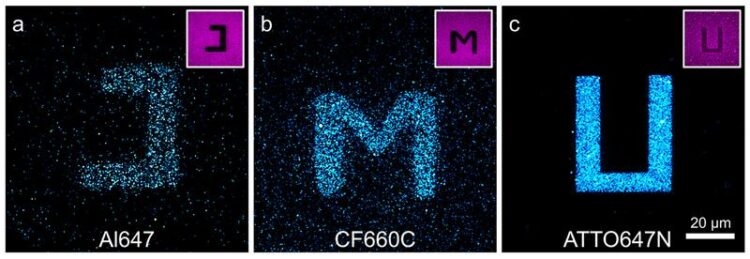How Photoblueing Disturbs Microscopy

Three dyes used for fluorescence microscopy. The carborhodamine dye (r.) shows more efficient photoblueing than the two cyanine dyes.
Team Markus Sauer / University of Würzburg
An undesirable effect can occur in super-resolution fluorescence microscopy: photoblueing. A new publication in „Nature Methods“ shows how it can be prevented or made useful for research.
The latest developments in fluorescence microscopy make it possible to image individual molecules in cells or molecular complexes with a spatial resolution of up to 20 nanometres. However, under certain circumstances, an effect occurs that falsifies the results: the laser light used can cause very reactive oxygen molecules to form in the sample. These can then damage the fluorescent dyes used to such an extent that they no longer fluoresce. Among microscopy experts, this effect is known as photobleaching.
However, various fluorescent dyes can also be transformed by photobleaching so that they absorb light of shorter wavelengths. “A previously red fluorescent dye then glows green. Its fluorescence has been shifted towards the blue range on the wavelength scale. This is why this effect is called photoblueing,” explains Professor Markus Sauer, an expert in super-resolution microscopy from the Biocentre of Julius-Maximilians-Universität Würzburg (JMU) in Bavaria, Germany.
First exact description of photoblueing
Sauer’s team now presents the exact molecular mechanism of photoblueing for cyanine dyes like Cy5 for the first time in the journal Nature Methods. Dr. Martin Schnermann from the Center for Cancer Research in Frederick (USA) is also involved in the publication.
“Because we understood the mechanism so precisely, we were able to prevent photoblueing by simple additives such as vitamin C or to increase it by adding a kind of catalyst,” says Markus Sauer.
Preventing photoblueing can be quite important. Although the effect can only affect a few percent of the dye used, it can nevertheless lead to errors or misinterpretations of the microscopy, for example in energy transfer experiments (FRET). This is because the converted dyes are detected with the same high sensitivity as the starting products.
Simple buffers prevent photoblueing
“Our results show which dyes are affected and how photoblueing can be prevented by simple buffer additions,” Sauer summarises the contents of the Nature Methods paper. “But they equally show how photoblueing can possibly be used advantageously for fluorescence imaging and for tracking single, specifically converted dye molecules.”
That’s exactly what Sauer’s team plans to tackle next: Photoblueing is to be further developed for, among other things, the targeted tracking of individual bacterial and viral particles in infection processes. The work described here was funded by the German Research Foundation DFG.
Wissenschaftliche Ansprechpartner:
Prof. Dr. Markus Sauer, Chair of Biotechnology and Biophysics, University of Würzburg, T +49 931 31-88687, m.sauer@uni-wuerzburg.de
Originalpublikation:
Photoblueing of organic dyes can cause artifacts in super-resolution microscopy. Dominic A. Helmerich, Gerti Beliu, Siddharth S. Matikonda, Martin J. Schnermann, Markus Sauer. Nature Methods, 25 February 2021, https://doi.org/10.1038/s41592-021-01061-2
Media Contact
All latest news from the category: Life Sciences and Chemistry
Articles and reports from the Life Sciences and chemistry area deal with applied and basic research into modern biology, chemistry and human medicine.
Valuable information can be found on a range of life sciences fields including bacteriology, biochemistry, bionics, bioinformatics, biophysics, biotechnology, genetics, geobotany, human biology, marine biology, microbiology, molecular biology, cellular biology, zoology, bioinorganic chemistry, microchemistry and environmental chemistry.
Newest articles

Pinpointing hydrogen isotopes in titanium hydride nanofilms
Although it is the smallest and lightest atom, hydrogen can have a big impact by infiltrating other materials and affecting their properties, such as superconductivity and metal-insulator-transitions. Now, researchers from…

A new way of entangling light and sound
For a wide variety of emerging quantum technologies, such as secure quantum communications and quantum computing, quantum entanglement is a prerequisite. Scientists at the Max-Planck-Institute for the Science of Light…

Telescope for NASA’s Roman Mission complete, delivered to Goddard
NASA’s Nancy Grace Roman Space Telescope is one giant step closer to unlocking the mysteries of the universe. The mission has now received its final major delivery: the Optical Telescope…



